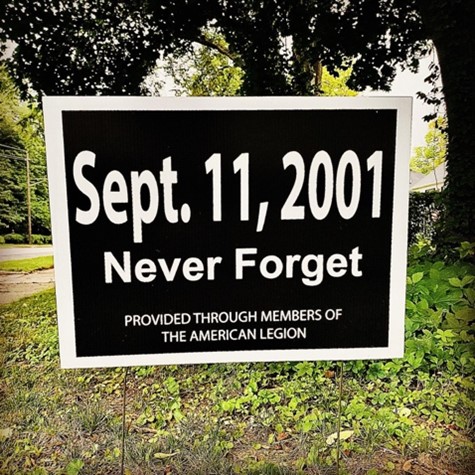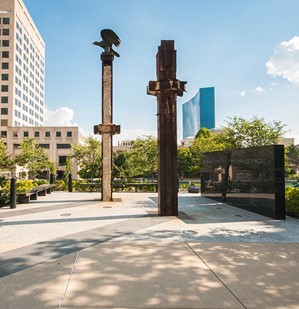If we are collectively cursed by our inability to comprehend history, historians carry the burden of seeing reminders of that ignorance everywhere. And so I feel acutely annoyed by yard signs planted in different neighborhoods of Indianapolis imploring us to “Never Forget.” Most of the signs I see are all black with white lettering, though some also have references to the American flag or the Twin Towers or first responders. The sign’s owners I’m sure assume that the point should be self-evident, but it’s not. And my question—WHAT should we never forget?—drives my historical senses crazy.
Events marking the twentieth anniversary of terrorist attacks that destroyed the Twin Towers in lower Manhattan, a large section of the Pentagon, and brought down a fourth airline in Pennsylvania will overwhelm news reports and social media feeds for at least the weekend of September 11 and 12. They  will cap a two decades long development of memorializations of the attacks, and they will, almost without fail, be wildly ahistorical and anti-historical. The yard signs are in a way so perfect because their message obscures so much of what came before and after a particular day in history. But that obscurity is what keeps historians working so diligently, of course, and these yard signs are a poignant reminder of why we work.
will cap a two decades long development of memorializations of the attacks, and they will, almost without fail, be wildly ahistorical and anti-historical. The yard signs are in a way so perfect because their message obscures so much of what came before and after a particular day in history. But that obscurity is what keeps historians working so diligently, of course, and these yard signs are a poignant reminder of why we work.
In the spirit of historians at work, I offer just an observation of how at least part of the Midwest seems to remember 9/11. Indianapolis has a memorial to 9/11. In some ways, this is entirely appropriate—the city has more memorials to war than any other city in the United States other than Washington D.C. In other ways—many, many other ways—this memorial is typically ridiculous.[i]
The United States was not at war when the attacks happened. Or was it? Nothing in the memorial speaks to the decades of killing and dying instigated by the U.S government in the Middle East preceding 9/11. However, if this memorial fits into the city’s relationship to war and to the history of war that needs to be commemorated, then it might seem appropriate to address the wars that followed. The memorial does not.

The site opened on the tenth anniversary of 9/11, with plenty of time to take stock of wars raging in both Iraq and Afghanistan. Instead, the memorial consists of two beams from the Twin Towers and a life-size sculpture of a bald eagle, facing east (toward NYC) with wings outstretched. On the website of the memorial the only argument linking the design to an interpretation of the event reads: “In designing the Memorial, it was the architect’s vision to recreate both emotionally and symbolically the experience of being at the World Trade Center site. His purpose was to make the Memorial as real today as for future generations and to always remember what happened on September 11, 2001.” What happened is not really in any dispute—how and why it happened is quite a bit messier.
Indianapolis has accomplished building a monument to a single event—like a birthday candle. Of course, this event happened over a thousand miles away and had very limited bearing on the residents of the state. One military officer from Indiana died when terrorists crashed the plane he was on into the Pentagon; and a group of first responders from the state worked tirelessly and dangerously in lower Manhattan immediately after the collapse of the towers. Both are stories to be told and remembered but that is not the point of the memorial.
Far more important, and I think dangerous, is the message literally carved into stone at the memorial. Rather than encourage donations to, say, the retirement or healthcare of first responders, the site asks for donations to the Indiana War Memorials Foundation. But to what end? For the sake of us. For the “we” created in the time of war. The wall which is “broken in two” has a singular message—that in tragedy, Americans came together, forgetting (?) or setting aside or looking beyond their differences to be one. The wall tells us: “We are one color, one class, one generation, one gender, one faith, one body, one family, one soul, one people. We are the power of one. We are united. We are America.” No, we’re not. And we should be grateful to have more than the power of one.
A few years ago I participated in a conference on finding common ground between progressives and conservatives. My contribution was to argue that in war, finding common ground can often be very bad for the common good. I look at Indy’s 9/11 memorial as an exhibit supporting my argument. Do we want to support our fellow citizens of need and tragedy? Absolutely! But if our present crisis is any indication, with a death of toll of a 9/11 every week, we seem to have evidence that we are far from a “one” of anything. Do we need to mourn as a nation? Of course, but I refer us to Susan Sontag’s searing comment in the wake of 9/11: “Let’s by all means grieve together. But let’s not be stupid together.” Finally, back to those yard signs. They are provided by the American Legion—whose headquarters are in Indy—and the money raised by sales of the sign go to…you guessed, the Indiana War Memorials Foundation. So I propose my own tribute: Never Forget that we have alternatives to war. Never Forget that war does not unite us into a “one” of anything. And Never Forget that historians will not allow us to remember our past as if it’s a yard sign.
[i] For bookends on this subject see: my book God and War, a work that attempts to account for the intellectual and theological arguments that have often provided popular moral support to American wars. More recently, Samuel Moyn in his new book Humane: How the United States Abandoned Peace and Reinvented War brilliantly dissects the legal, cultural, and intellectual architecture that has imprisoned the nation in a commitment to fighting and killing and dying without end.

2 Thoughts on this Post
S-USIH Comment Policy
We ask that those who participate in the discussions generated in the Comments section do so with the same decorum as they would in any other academic setting or context. Since the USIH bloggers write under our real names, we would prefer that our commenters also identify themselves by their real name. As our primary goal is to stimulate and engage in fruitful and productive discussion, ad hominem attacks (personal or professional), unnecessary insults, and/or mean-spiritedness have no place in the USIH Blog’s Comments section. Therefore, we reserve the right to remove any comments that contain any of the above and/or are not intended to further the discussion of the topic of the post. We welcome suggestions for corrections to any of our posts. As the official blog of the Society of US Intellectual History, we hope to foster a diverse community of scholars and readers who engage with one another in discussions of US intellectual history, broadly understood.
The memorial you write so dismissively of does not intend to nor does it need to “[fit] into the city’s relationship to war and to the history of war that needs to be commemorated.” You seem to want a different memorial. The Indiana 9/11 Memorial is about remembrance of the lives lost as a result of terrorist attacks on September 11, 2001. That *is* the point of the memorial. I appreciate a good contrarian take (and your disagreement with the sentiment of Cheryl Sawyer’s “One” poem makes a fine point), but it has to first be honest and in good-faith, and your blog post misses that.
The memorial commemorates the death of people of September 11 but doesn’t stop there–it clearly indicates an interpretation of what those deaths mean and who sponsors that interpretation. If remembering those who died is the point, I look forward to the American Legion sponsoring a Covid-19 memorial. I don’t thing that will happen, not because the American Legion is heartless but because 9/11 fits into a story about American unity in a time of war. That is a problem that rarely gets addressed in the U.S. much less here in Indy.